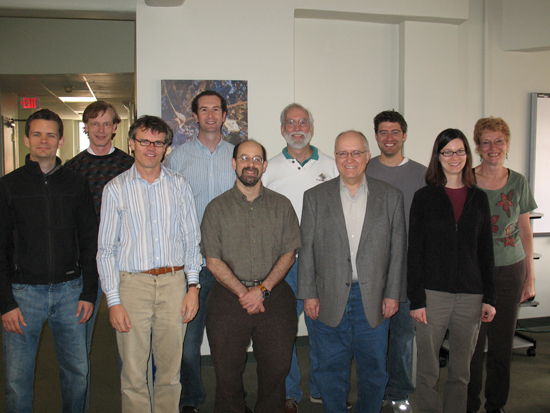NCEAS Working Groups
Effects of trade policy on management of non-native forest pests and pathogens
Project Description
This working group will explore whether federal records on interceptions of non-native forest pests and pathogens can be used to identify species that may colonize the United States during the next several decades. The group will attempt to estimate the economic and ecological costs of such colonizations given different volumes and origins of trade. In addition, the group will explore how different policies related to interdiction, detection, or eradication may affect costs.

Principal Investigator(s)
James A. Turner
Project Dates
Start: April 1, 2008
End: October 31, 2010
completed
Participants
- Juliann E. Aukema
- University of California, Santa Barbara
- Gregory N. Bratman
- University of California, Santa Barbara
- Kerry O. Britton
- USDA Forest Service
- Eckehard G. Brockerhoff
- Scion
- Joseph F. Cavey
- USDA Animal and Plant Health Inspection Service (APHIS), PPQ
- Bill Dickerson
- USDA Animal and Plant Health Inspection Service (APHIS)
- Erica Fleishman
- University of California, Santa Barbara
- Lynn J. Garrett
- USDA Animal and Plant Health Inspection Service (APHIS)
- Robert A. Haack
- USDA Forest Service
- Stephanie E. Hampton
- University of California, Santa Barbara
- Andrew M. Liebhold
- USDA Forest Service
- Fernandez Linda
- University of California, Riverside
- Frank Lowenstein
- The Nature Conservancy
- Carissa Marassas
- USDA Animal and Plant Health Inspection Service (APHIS), PPQ
- Amelia Nuding
- University of California, Santa Barbara
- Thomas L. O'Halloran
- University of California, Santa Barbara
- Lars J. Olson
- University of Maryland, College Park
- Matthew H. Royer
- USDA Animal and Plant Health Inspection Service (APHIS), PPQ
- Margaret A. Shannon
- State University of New York (SUNY)
- Erin Sills
- North Carolina State University
- Christa L. Speekmann
- USDA Animal and Plant Health Inspection Service (APHIS), PPQ
- Michael Springborn
- University of California, Davis
- James A. Turner
- Scion
- Christina Vieglais
- University of California, Santa Barbara
- Trang T. Vo
- USDA Animal and Plant Health Inspection Service (APHIS)
Products
-
Presentations / 2010
Pest pathways and impacts
-
Presentations / 2009
Insights from wood borer and bark beetle invasions in New Zealand and overseas
-
Presentations / 2010
Demonstrating the benefits of phytosanitary regulations: The case of ISPM 15
-
Presentations / 2010
Demonstrating the benefits of phytosanitary regulations: The case of ISPM 15 for the United States
-
Presentations / 2010
Using border interception records to estimate borer arrival rates and effects of phytosanitary policy
-
Journal Article / 2014
Predicting how altering propagule pressure changes establishment rates of biological invaders across species pools
-
Presentations / 2010
Borer invasions in North America: Buprestidae, Cerambycidae, and Siricidae
-
Presentations / 2010
International efforts to slow the arrival of exotic forest pests
-
Presentations / 2010
International policies, standards and programmes to reduce wood and bark borer invasions
-
Presentations / 2010
ISPM No 15 and wood-infesting insects: Considerations in developing efficacy testing criteria
-
Presentations / 2011
Domestic and international efforts to reduce introductions of bark- and wood-boring insects
-
Presentations / 2011
Exotic wood boring insects and the wood industry: Domestic and international linkages
-
Presentations / 2011
Invasive bark- and wood-infesting insects worldwide: Establishment patterns, international trade, and efforts to slow the flow
-
Presentations / 2011
ISPM No. 15 and the incidence of wood pests: Recent findings, policy changes, and current knowledge gaps
-
Presentations / 2012
Challenges in assessing the effectiveness of international and domestic treatments for wood packaging and firewood
-
Journal Article / 2014
Effectiveness of the international phytosanitary standard ISPM No. 15 on reducing wood borer infestation rates in wood packaging material entering the United States
-
Journal Article / 2017
Depletion of heterogeneous source species pools predicts future invasion rates
-
Presentations / 2009
Trade and forest invasives working group, fall 2009 update
-
Presentations / 2010
Trade, economics, and invasives: The Nature Conservancys perspective
-
Presentations / 2011
Trends and factors that influence pest interception rates in wood packing materials
-
Presentations / 2010
Environmental externalities of international trade and transport
-
Presentations / 2013
Pathway analysis of trade policy for invasive species risk: The net benefits of ISPM-15 in the US
-
Presentations / 2010
Economic impact and global trade implications of phytosanitary treatments for wood packaging material
-
Journal Article / 2013
Evaluating the impacts of an international phytosanitary standard for wood packaging material: Global and United States trade implications
-
Presentations / 2010
Demonstrating the benefits of phytosanitary regulations: The case of ISPM 15 for the United States
